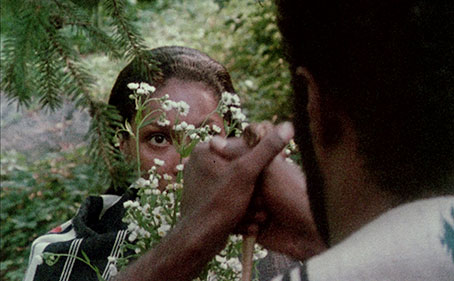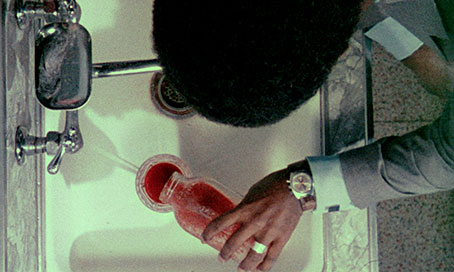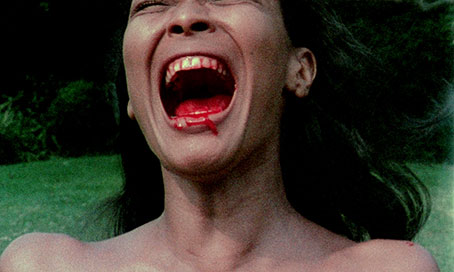|
If you're an old school horror fan, hear the words Vampire and Blaxploitation in the same sentence and there's a good chance a picture of William Marshall as Blacula will pop into your head. It's hardly surprising. Not only was Blacula the most famous black vampire of the 1970s, he remains one of the coolest in the genre's toothy history. His first appearance on film was also a big hit, and so studio execs, in that creative way they have, began looking to make other black vampire movies that might emulate its commercial success.
It was the result of this feeding frenzy that saw respected African-American scriptwriter Bill Gunn offered the chance to direct his first feature film. The trouble is the last thing he wanted to make was a black vampire movie. But with the long-awaited chance to direct his first feature being dangled right in front of his nose, he accepted the offer and penned a script for Ganja & Hess that the execs seemed to like. What they didn't realise was that Gunn never intended to follow it to the letter, but use it instead as a kicking off point for a semi-experimental study of addiction and the black American identity of the day. The resulting film dismayed the money men so much that they demanded a re-edit, one that the filmmakers refused to supply. They thus recut it themselves, adding material that Gunn had shot but rejected, and yet still managed to shorten it by a staggering 32 minutes, in the process transforming it into a sexploitation drama that bore precious little resemblance to the film Gunn had made. Gunn, producer Ciz Schultz and editor Victor Kanefsky promptly had their names removed from this version of the film, which was released as the crudely retitled Blood Couple. For years this was the only form in which the film could be seen.

The current restoration of Ganja & Hess (and yes, Gunn was fully aware of the drug reference in that title) to its original form was carried out by the Museum of Modern Art back in 1998 with support from The Film Foundation, and first made available on US DVD from All Day Entertainment, a project supervised by our favourite supplier of expert commentaries, David Kalat. In 2012, it was remastered in HD for an American Blu-ray release by Kino Lorber, and now it arrives on dual format in the UK from Eureka for an audience that will, for the most part, have probably been previously unaware of its existence.
So what was it that so pissed off the money men back in 1973? A basic plot summary provides no real clues. Dr. Hess Green (Duane Jones in his only starring role apart from Night of the Living Dead), a wealthy and respected anthropologist who is studying the ancient, blood-drinking African civilisation of Myrthia, takes on a new assistant in the shape of George Meda (played by director Bill Gunn). Meda, it turns out, is both neurotic and suicidal, and one night (for reasons that are never really made clear) he attacks and seemingly kills his employer with a Myrthian dagger. Meda then takes his own life, but Dr. Green quickly recovers from the assault with no visible wounds and an urgent thirst for blood. A few months later, Meda's wife Ganja (Marlene Clark) turns up in search of her husband and soon falls for the taciturn but sophisticated Dr. Green. But as their relationship develops, how long can Green keep his dark secret from Ganja?

Nothing too problematic here, you might think, but that's because you're reading about it rather than seeing it. Precious little about Gunn's handling is by the film storytelling book, with unconventionally framed shots held for longer than the established norm, and early conversations allowed to amiably ramble some way past the point when they have served their narrative or even character purpose. Then, just as you acclimatise yourself to this offbeat approach, you get a sudden burst of surrealistic dream imagery or a scene that is so snappily shot and cut (the sequence in which Green distracts medical staff with a bin fire to enable him to steal some transfused blood is a masterclass in economic storytelling) that it almost feels as if it's been spliced in from a different movie. And you'll need to pay close attention to the soundtrack as well, as key information is delivered not just in offhand lines of dialogue, but in the lyrics of the songs that form part of composer Sam Waymon's haunting score.
On my first viewing this all proved just a little disorientating, but a second screening prompted a complete rethink of what I thought I had seen, and saw me throw away my notes and start writing a new set. Elements that I previously found confusing came into sharp focus, and the buzz that you get from watching a filmmaker refusing to follow the rules and going their own way with the medium proved genuinely thrilling. The collision between narrative and experimental cinema does keep you on your toes and makes it nigh-on impossible to predict where the film will go next, but it never feels superfluous and always seems to be serving the narrative and its characters.
Gunn was also really ahead of the genre game here, something that's in danger of being obscured by the small army of vampire movies that followed in its wake. One of the first films to really explore the notion of vampirism as a metaphor for drug addiction, it is unabashed in its nudity and bold in its eroticism, but crucially binds them to the fabric of the film, in a way that ensures neither element feels exploitative. Directions that the genre would subsequently take are given their first outing here, and echoes of the film can be found in later works – a scene in which Green licks spilt blood up from the floor can't help but feel like a forerunner to a similar moment in Cronos, while a sequence in which a sexual encounter ends up as an almost literal bloodbath visually prefigures one of the most startling images from Angel Heart.

Ganja & Hess won't work for everyone. Its grainy Super-16mm imagery and experimentations with pace and form strip it of the sort of surface sheen that is almost the raison d'être of the Twilight series and its ilk, aligning it more with Abel Ferrara's similarly themed The Addiction, which Gunn's film predates by an impressive 22 years. The style-shifting also gives rise to some of the most striking imagery in 70s vampire cinema, from a horribly realistic throat incision (whose effect is muted a tad by the watery orange blood, which may well be a print discolouration issue) to the mesmerising slow-motion shot of an African tribeswoman adorned with a long-feathered headdress that seems to transport the sleeping Green back to the origins of the vampire cult whose curse he now carries. Bold, challenging and adventurous in a way that so few independent films seem to be any more, it's a fascinating and ultimately rewarding rediscovery that deserves now to find the audience it was denied back in 1973.
I've read a couple of different stories about the source material that was used for restoration on which this transfer was based. One claims that much of the material was struck from the original negative, while the other that because the negative had been recut into the version that became Blood Couple, the restoration had to be made largely from prints of varying quality, something a couple of comments in the featurette below lend some credence to. Certainly the image quality here is not going to compete with a Hollywood feature shot in the Californian sun on low speed 35mm stock – the grain is more prominent, the colour more subdued, and the level of detail visibly lower than the norm for a Blu-ray transfer. A scene set at a garden party suffers particularly here, being visually glum, lacking in sharpness and dancing with film grain. But this is low budget filmmaking from a time when shooting on higher speed 16mm film stock meant making a few sacrifices in other areas, and in that respect the image is probably par for the course. Intermittently, however, the picture detail really sharpens up, and the sometimes aggressive contrast evens out to provide a really pleasing tonal range. The image is also largely clean, despite a few traces of former damage, the occasional scratch and hair, and the odd small spray of dust spots. And while it may make me sound like a bit of an excuse monkey, I'd suggest this aesthetic really lends itself to the film's sometimes striking documentary feel. The picture is framed 1.66:1, which feels about right.

The Linear PCM 2.0 mono soundtrack also struggles a little in places, with a very audible background hiss evident in quieter scenes and even some of the louder ones. But despite the unsurprising range restrictions, the dialogue is always clearly audible, even when mumbled, and the music score sounds fine.
Optional English SDH subtitles are also available.
The Blood of the Thing (29:41)
A documentary featurette, produced for the earlier DVD restoration and presented by David Kalat, that looks back at the making and subsequent fate of Ganja & Hess. Based primarily around interviews with producer Chiz Schultz and editor Victor Kanefsky, it includes brief contributions from director of photography James Hinton and assistant producer Janice Adams recorded at a screening of the restored cut of the film. How much of this will be new to you may well depend on whether you watch this before listening to the main audio commentary, as some of the stories from there are repeated here, but it's still all interesting stuff, particularly the recollections of working with director Bill Gunn, whom everyone clearly had enormous respect for. There's an alarming story about pressure applied by the notorious Teamsters union, detail on how the film changed on set from the original script, and Schultz and Kanefsky recall their dismay at first seeing the recut version of the film. One thing that did make me scratch my head was the claim made by the contemporary critical establishment that this wasn't the right time for a black art film. When, exactly, would be the right time?
Selected Scene Commentary (17:45)
David Kalat, in his role as DVD producer for All Day Entertainment, kicks off this self-titled "short attention span" commentary by pleading with us not to watch this until after we've listened to the filmmaker's commentary, which makes you wonder why it's positioned above that particular feature on the extras menu. It matters not. Kalat only talks over two sequences, but 17 minutes of David Kalat is as rich with information as a good many other audio commentaries are in their entirety. He fascinatingly deconstructs the complex opening scene, which he suggests crams the first 26 pages of the original screenplay into 5 minutes of screen time, and even offers an alternative reading of events that had not occurred to me. He follows this with an exploration of the film's final sequence (so definitely don't watch this before seeing the film itself), gives a shout for Phillip Fenty's 1977 Blaxploitation actioner The Baron, and intriguingly links story elements of Ganja & Hess to the so-so 1974 Amicus movie, The Beast Must Die. Seriously good stuff.

Feature-Length Commentary
Producer Chiz Schultz, lead actress Marlene Clark, cinematographer James Hilton and composer Sam Waymon look back on a film that they all clearly enjoyed working on and remain justly proud of, at least in this form. Some of the stories from the featurette are repeated here, but so much is new that you can comfortably watch the documentary first and not experience any serious déjà-vu here. Hilton and Waymon provide plenty of useful information about the cinematography and music score, Clark reveals that she had no problem with the nudity because she has such faith in the project and its director, and Schultz recalls one time when one of the production crew was pistol whipped in the street and the film's payroll was stolen. Yikes. Intriguingly, Hilton claims this was the only film he has worked on where no-one was fired and everyone did their job without issue or complaint, and all recall the late film sequence when the staging of a feverish sermon sent actor Duane Jones into a shuddering trance. There's loads more here. A fine commentary track and a great accompaniment to the film itself, though who the hell was it that allowed someone sitting right next to the microphone to intermittently raid a loudly rattling box of Tic Tac mints?
Booklet
Bookended by two versions of the original poster, the booklet includes a typically detailed and knowledgeable essay on the film by Kim Newman, a 1973 letter from Bill Gunn to the New York Times responding impressively to their negative critical reaction, some high quality behind-the-scenes stills, credits for the film and briefer than usual advice on setting up your TV.
I was a little uncertain about Ganja & Hess after my first viewing, but second time around I experienced a serious epiphany and by the third I was marvelling at its boldness, its complexity, its forward thinking, and its fuck-you refusal to play by the rules. Eureka has done well by the film here, with all the extra features from the All Day special edition American DVD release, plus a transfer that's probably as good as the current condition of source material allows. Recommended.
|